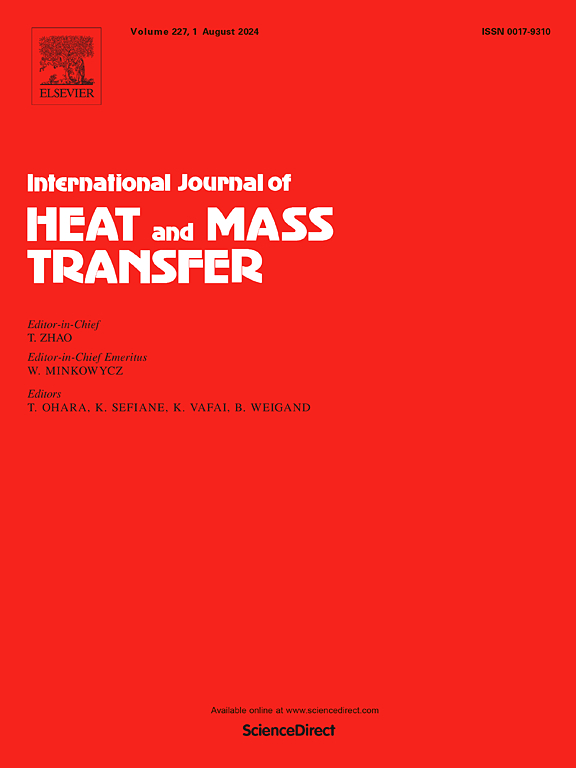Slosh induced forced convection enhances heat transfer in a partially filled PCM capsule
IF 5
2区 工程技术
Q1 ENGINEERING, MECHANICAL
International Journal of Heat and Mass Transfer
Pub Date : 2025-04-27
DOI:10.1016/j.ijheatmasstransfer.2025.127161
引用次数: 0
Abstract
The melting heat transfer inside a capsule partially filled with phase change material (PCM) under reciprocating movement can be frequently encountered in novel energy storage devices such as fluidized bed or rotary drum. However, influence of liquid sloshing on the melting is rarely investigated. In this study, an experiment adopting image processing is established to visually study the transient melting of PCM when the capsule is reciprocating at different amplitudes and frequencies. n-Hexadecane is adopted as the PCM and volume filling ratios from 30 % to 90 % are covered. The solid PCM is fixed by a stick inside the capsule, thus forming constraint melting. Reciprocating movement of the capsule is realized through a crank-slider mechanism, with frequency in 0.7Hz-1.1 Hz and amplitude of 50 mm and 75 mm. The results show the slosh of the melted PCM inside a reciprocating capsule gets stronger with the increase of amplitude and frequency. The transient melting heat transfer coefficient (HTC) demonstrates a trend of first increase and then decrease with time, but both transient and averaged HTCs increase with reciprocating amplitude or frequency. The slosh of the melted PCM induces the liquid forced convection, boosting the heat transfer and this effect is suppressed by larger volume filling ratio. An empirical correlation to predict the enhancement is also fitted to assist the design of related energy storage device.
晃动诱导的强制对流增强了部分填充的PCM胶囊内的传热
在流化床或转鼓等新型储能装置中,经常会遇到部分填充相变材料(PCM)的胶囊在往复运动下的熔化传热问题。然而,很少研究液体晃动对熔化的影响。本研究采用图像处理的方法建立了一个实验,直观地研究了胶囊在不同振幅和频率下往复运动时PCM的瞬态熔化。PCM采用正十六烷,体积填充率为30% ~ 90%。固体PCM被一根棒固定在胶囊内,从而形成约束熔化。胶囊的往复运动通过曲柄滑块机构实现,频率为0.7Hz-1.1 Hz,振幅为50 mm和75 mm。结果表明:随着振幅和频率的增加,往复胶囊内熔化PCM的晃动越来越强;瞬态熔融换热系数(HTC)随时间呈先增大后减小的趋势,但瞬态和平均HTC均随振幅或频率的往复而增大。熔融PCM的晃动引起了液体强制对流,促进了传热,较大的体积填充比抑制了这一作用。并拟合了预测增强的经验关联,以辅助相关储能装置的设计。
本文章由计算机程序翻译,如有差异,请以英文原文为准。
求助全文
约1分钟内获得全文
求助全文
来源期刊
CiteScore
10.30
自引率
13.50%
发文量
1319
审稿时长
41 days
期刊介绍:
International Journal of Heat and Mass Transfer is the vehicle for the exchange of basic ideas in heat and mass transfer between research workers and engineers throughout the world. It focuses on both analytical and experimental research, with an emphasis on contributions which increase the basic understanding of transfer processes and their application to engineering problems.
Topics include:
-New methods of measuring and/or correlating transport-property data
-Energy engineering
-Environmental applications of heat and/or mass transfer

 求助内容:
求助内容: 应助结果提醒方式:
应助结果提醒方式:


